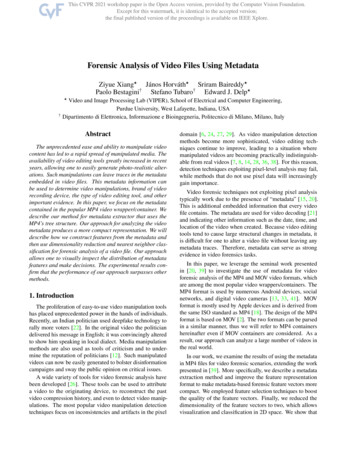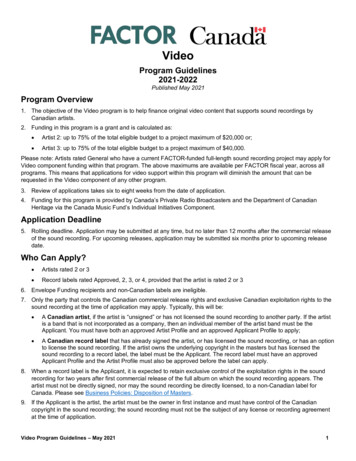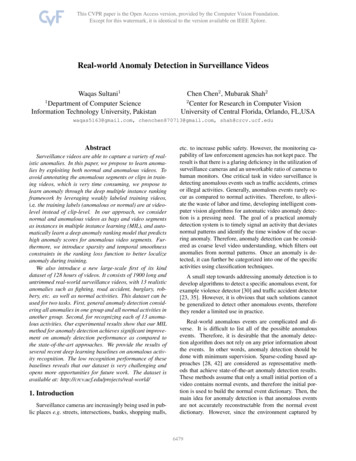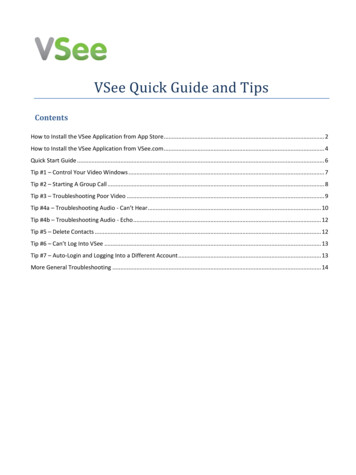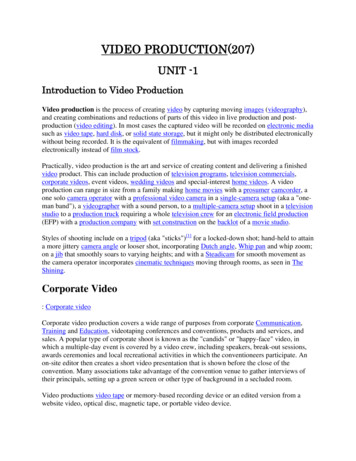
Transcription
VIDEO PRODUCTION(207)UNIT -1Introduction to Video ProductionVideo production is the process of creating video by capturing moving images (videography),and creating combinations and reductions of parts of this video in live production and postproduction (video editing). In most cases the captured video will be recorded on electronic mediasuch as video tape, hard disk, or solid state storage, but it might only be distributed electronicallywithout being recorded. It is the equivalent of filmmaking, but with images recordedelectronically instead of film stock.Practically, video production is the art and service of creating content and delivering a finishedvideo product. This can include production of television programs, television commercials,corporate videos, event videos, wedding videos and special-interest home videos. A videoproduction can range in size from a family making home movies with a prosumer camcorder, aone solo camera operator with a professional video camera in a single-camera setup (aka a "oneman band"), a videographer with a sound person, to a multiple-camera setup shoot in a televisionstudio to a production truck requiring a whole television crew for an electronic field production(EFP) with a production company with set construction on the backlot of a movie studio.Styles of shooting include on a tripod (aka "sticks")[1] for a locked-down shot; hand-held to attaina more jittery camera angle or looser shot, incorporating Dutch angle, Whip pan and whip zoom;on a jib that smoothly soars to varying heights; and with a Steadicam for smooth movement asthe camera operator incorporates cinematic techniques moving through rooms, as seen in TheShining.Corporate Video: Corporate videoCorporate video production covers a wide range of purposes from corporate Communication,Training and Education, videotaping conferences and conventions, products and services, andsales. A popular type of corporate shoot is known as the "candids" or "happy-face" video, inwhich a multiple-day event is covered by a video crew, including speakers, break-out sessions,awards ceremonies and local recreational activities in which the conventioneers participate. Anon-site editor then creates a short video presentation that is shown before the close of theconvention. Many associations take advantage of the convention venue to gather interviews oftheir principals, setting up a green screen or other type of background in a secluded room.Video productions video tape or memory-based recording device or an edited version from awebsite video, optical disc, magnetic tape, or portable video device.
Television BroadcastVideo Production of a Political Commercial, San Diego, California, 2004Betacam SP video production was the broadcast television standard from the early 1980s up untilthe beginning of the 21st Century when many television stations began using digital media toshoot, transmit and store High-definition (HD) footage. Two styles of producing video are ENG Electronic news-gathering and EFP - Electronic field production. Television broadcastproductions include television commercials, infomercials, newscasts, entertainment shows,documentaries, news magazines, sitcom and reality shows. They may be distributed by broadcastsyndication.Event VideoEvent videographyVideo production can be used at sporting, school, stage, wedding, church, and similar events toprovide recordings of the events. Event video productions range in distribution from a weddingvideo that is custom made for a bride and groom and their immediate family and friends, to adance recital where dozens to hundreds of videos are sold to individual dancers. Event videoproduction can also be used to broadcast events live to viewers at home such as a pressconference or concert. Video of live events can be sent by microwave or a satellite truck from theevent location to a television studio in order to be broadcast.[2]Explainer VideoExplainer videos incorporate animation as the primary visual element. There are two main typesof explainer videos: Whiteboard and Cartoon. Both types are used to convey messages that aretechnical in nature. By using the explainer type of videos, the viewer has a better understandingof the concept of the message being presented.Marketing VideoMarketing videos are used to promote an organization or product and create awareness amongconsumers. Marketing video production ranges from television advertisements to internetcommercials and viral videos.Real Estate video productionReal Estate video productions consists of shooting footage of properties and editing them intoshort videos; the final videos could include footage, graphics, titles, animations, and voice over.
Video production for distance educationVideo production for distance education is the process of capturing, editing, and presentingeducational material specifically for use in on-line education. Teachers integrate best practiceteaching techniques to create scripts, organize content, capture video footage, edit footage usingcomputer based video editing software to deliver final educational material over the Internet. Itdiffers from other types of video production in three ways: 1. It augments traditional teachingtools used in on-line educational programs. 2. It may incorporate motion video with sound,computer animations, stills, and other digital media. 3. Capture of content may include use ofcell phone integrated cameras and extend to commercial high-definition Broadcast qualitycameras. The primary purpose of using video in distance education is to improve understandingand comprehension in a synchronous or asynchronous manner.[3]Webcasting is also being used in education for distance learning projects; one innovative use wasthe DiveLive[4] programs. Detailing an exploration of a notable shipwreck, Nautilus Productionshas a webpage reading,″In the fall of 2000 Rick Allen's Nautilus Productions co-produced with Bill Lovin of MarineGrafics a groundbreaking, week long live internet broadcast known as QAR DiveLive from theBlackbeard wreck site.[5] For the first time ever, live video and audio was broadcast from anunderwater archaeological site to the World Wide Web. Students were able to watch theunderwater archaeology in real time and ask questions of the scientists exploring the shipwreck.The twice-daily live distance learning programs reached an estimated 1600 students from as faraway as Canada during the five days of broadcasting. In October of 2001 Allen and Lovin againco-produced QAR DiveLive 2001. This time the interactive webcasts from the seafloor andconservation laboratories of the Queen Anne's Revenge Shipwreck Project reached over 3600students and another 2700 remote viewers from fifteen states and 2 countries during the five daysof broadcasts.″Internet Video ProductionPlay mediaA marketing video for the Wikimedia FoundationMany websites include videos. These videos are not necessarily produced online, although thereare many video production tools that allow the production of videos without actually using aphysical camera. An example of this is using the YouTube video editor to create a video usingpre-existing video content that is held on the platform under creative commons license.Video content is being used in an ever growing range of contexts on websites. There aretestimonial videos, web presenter videos, help section videos, interviews, parodies, productdemonstrations, training videos, thank you videos and apology videos.
Many internet marketing videos are made in home based environments,[6] however businessestoo can use internet videos for the purpose of interacting with the audience. There are two maintypes of internet marketing videos: transactional videos, aiming to sell a product to a customer,and reference videos, aiming to keep the customer on the website.[citation needed]Individual internet marketing videos are primarily produced in-house and by small mediaagencies, while a large volume of videos are produced by big media companies, crowdsourcedproduction marketplaces or in scalable video production platforms. Most types of internetmarketing videos serve the purpose of interacting with the audience, and there are two maintypes of internet marketing videos: transactional videos, aiming to sell a product to a customer,and reference videos, aiming to keep the customer on the website.Training VideoTraining videos are commissioned by organizations to promote or make changes in workforce.This can range throughout the organization from training for those that need to learn simple,repetitive tasks and up to executive training. In addition, organizations often purchase or rentmore generic training videos to minimize costs. Such videos would include safety, first aid, timemanagement, sales skills, etc.Process of Video ProductionPre-ProductionScripting & Storyboard – The pre-production phase of a project is where all the planning takesplace before the camera rolls. Whether its measured in minutes, hours or days, this planningphase sets the overall vision of the project. Pre-production also includes working out the shootlocation and casting. You’re in pre-production mode the moment you start writing down a fewpoints to cover in a video even if it is a short piece made for a blog. As your projects becomemore ambitious you can start to storyboard the project. Storyboards can really smooth out thepost-production process when it’s time for editing. This will really be useful if there are multiplepeople working on the project.This 1st step of the video production process is the planning, research,problem-solving and organizational work you do before the shooting starts.This phase includes. The video's conceptScriptStoryboardFunding
Facilities, etc. .All that has to be planned for and brought together to produce the video.Without a good plan and organization the production of the video canbecome a grind! Make sure that you have a very good idea of what it takesas far as structure of the video, time needed for production, equipment andpersonnel before you start making your video.Having a good "vision" of what it will take will save you a lot of time, moneyand aggravation I assure you! And even if it's a small-time production. the kidsbirthday party for instance It's always a good idea to work it out a little bit ahead of time (even if it's just in your head)where you want to set up, what kind of shots do you want to take and what do you want toinclude in the video so that you are sure to capture all the special events of the day that willturn into great memories in the future!ProductionProduction begins once the footage is recorded. This process will capture all the scenes andinformation captured in the pre-production process. During the production process you will workout the lighting requirements, framing and composition. Some projects will also shoot B-Rollduring the production process. B-Roll is supplementary footage that is included in the finishedproduct.The production phase is the actual production (making) of the material neededfor the video.It's at this stage of the video production process that you are actually producingthe.
GraphicsDoing the cameraworkAnimationMusicSoundLighting effectsNarration andVideo footage etc.Needed for the project.At this stage you want to produce quality material so that you have plenty towork with when you go into the post production stage. Be sure to be as expert aspossible in your use of your equipment such as; your digital video camera,lighting equipment, sound equipment etc.Post-ProductionThe post production process begins after all the footage has been captured. This is actually oneof my favourite parts of the video making process. Graphics can be added along with images,music, colour correction and special effects. If you are producing your own video content therewill be a bit of a learning curve at first, but it will be really rewarding.Post-production is likeputting the last coat of paint on in a room and it will be well worth the time to learn the basics.This is where your video project will really come to life.The 3rd stage of the production process is called the post-productionphase. It is.The organization and digital videoediting of the material into theactual video.Post-production literally is where youbring together all of the differentelements and material created in theproduction phase to form yourfinished product as you envisioned in
the pre-production stage.This stage is the process of assembling and putting together the media assets andmaterial you have produced to form and finally produce your finished film orvideo project.Team of Video ProductionA film crew is a group of people hired by a production company for the purpose of producing afilm or motion picture. The crew is distinguished from the cast as the cast are understood to bethe actors who appear in front of the camera or provide voices for characters in the film. Thecrew is also separate from the producers as the producers are the ones who own a portion ofeither the film company or the film's intellectual property rights. A film crew is divided intodifferent departments, each of which specializes in a specific aspect of the production. Film crewpositions have evolved over the years, spurred by technological change, but many traditionaljobs date from the early 20th century and are common across jurisdictions and film-makingcultures.Motion picture projects have three discrete stages: development, production and distribution.Within the production stage there are also three clearly defined sequential phases — preproduction, principal photography and post-production — and many film crew positions areassociated with only one or two of the phases. Distinctions are also made between above-the-linepersonnel (such as the director, the screenwriter and the producers) who begin their involvementduring the project's development stage, and the below-the-line "technical" crew involved onlywith the production stage.A study of the 100 top-grossing films of each year between 1994 and 2013 found that there werean average of 588 crew credits per film,[1] however, profitable independent films have been madewith crews of less than a dozen.[2]Television crew positions are derived from those of film crew.DirectorThe director is considered to be a separate entity, not within the film crew's departmentalstructure. DirectorThe director is responsible for overseeing the creative aspects of a film, including controlling thecontent and flow of the film's plot, directing the performances of actors, organizing andselecting the locations in which the film will be shot, and managing technical details such as thepositioning of cameras, the use of lighting, and the timing and content of the film's soundtrack.Though directors wield a great deal of power, they are ultimately subordinate to the film's
producer or producers. Some directors, especially more established ones, take on many of theroles of a producer, and the distinction between the two roles is sometimes blurred. Second unit directorThe second unit director is responsible for overseeing the photography assigned to the secondunit, which can range from minor insert shots to large stunt sequences. The second unit directorposition is frequently filled by a member of the production, most often the editor or stuntcoordinator. Music directorIn India-based movie productions, many of which are musicals, the term 'music director' iscommonly used for the composer and music producer of the songs and score used in the film.The role involves supervising the arrangement, recording and mastering of film music along withconducting and orchestration.ProductionProduction is generally not considered a department as such, but rather as a series of functionalgroups. These include the film's producers and executive producers such as the productionmanager, the production coordinator, and their assistants; the various assistant directors; theaccounting staff; and sometimes the locations manager and their assistants. ProducerA film producer creates the conditions for film-making. The producer initiates, coordinates,supervises, and controls matters such as raising funding, hiring key personnel, and arranging fordistributors. The producer is involved throughout all phases of the film making process fromdevelopment to completion of a project. There may be several producers on a film who maytake a role in a number of areas, such as development, financing or production. Producers mustbe able to identify commercial, marketable projects. They need a keen business sense, and anintimate knowledge of all aspects of film production, financing, marketing and distribution.Producers are responsible for the overall quality control of productions. Executive producerAn executive producer (EP) is a producer who was not involved in the technical aspects of thefilm-making process in the original definition, but has played a financial or creative role inensuring that the project goes into production.[1] Today, however, the title has becomeambiguous,[2] particularly in feature films. Since the 1980s, it has become increasingly commonfor the line producer to be given the title of executive producer, while the initiating producertakes the "produced by" credit. On other projects, the reverse happens, with the line producer
taking the "produced by" credit. So the two credits have become effectively interchangeable,with no precise definition.Production office Line producerThe line producer is the liaison between the studio or producer and the production manager,responsible for managing the production budget. The title is associated with the idea that he orshe is the person who is "on the line" on a day-to-day basis, and responsible for lining up theresources needed. Production assistantProduction assistants, referred to as PAs, assist in the production office or in variousdepartments with general tasks, such as assisting the first assistant director with set operations.Production management Production managerThe production manager supervises the physical aspects of the production (not the creativeaspects) including personnel, technology, budget, and scheduling. It is the production manager'sresponsibility to make sure the filming stays on schedule and within its budget. The PM alsohelps manage the day-to-day budget by managing operating costs such as salaries, productioncosts, and everyday equipment rental costs. The PM often works under the supervision of a lineproducer and directly supervises the production coordinator. Assistant production managerThe assistant production manager is the assistant to the production manager (PM) and carriesout various jobs for the PM. Normally only big budget Hollywood feature films have an assistantPM. Unit managerThe unit manager fulfils the same role as the production manager but for secondary "unit"shooting. In some functional structures, the unit manager subsumes the role of the transportcoordinator. Production coordinator
The production coordinator is the information nexus of the production, responsible fororganizing all the logistics from hiring crew, renting equipment, and booking talent. The PC is anintegral part of film production.Assistant directors First assistant directorThe first assistant director (1st AD) assists the production manager and director. The ultimateaim of any 1st AD is to ensure the film comes in on schedule while maintaining a workingenvironment in which the director, principal artists ( actors) and crew can be focused on theirwork. They oversee day-to-day management of the cast and crew scheduling, equipment, script,and set. A 1st AD may also be responsible for directing background action for major shots or theentirety of relatively minor shots, at the director's discretion. Second assistant directorThe second assistant director (2nd AD) is the chief assistant of the 1st AD and helps carry outthose tasks delegated to the 1st AD. The 2nd AD may also direct background action and extras inaddition to helping the 1st AD with scheduling, booking, etc. The 2nd AD is responsible forcreating call sheets that let the crew know the schedule and important details about theshooting day. Other assistant directorsSometimes other assistant directors are needed such as in Canadian and British functionalstructures the 3rd assistant director (3rd AD) and even trainee assistant directors (trainee AD).In the American system there are 2nd 2nd assistant director (2nd 2nd AD). Normally in theamerican system 2nd 2nd ADs control big crowd extras and make sure if shooting on locationnone of the public get into shots.Accounting Production accountantProduction accountants manage the money and ensure the production comes in on budget andeveryone gets paid. The industry is notorious for unusual accounting methods which arecollectively labelled Hollywood accounting. Production accountants are often assisted byassistant accountants, sometimes called clerks, responsible accounts receivable, accountspayable and payroll.Locations Location manager
Oversees the locations department and its staff, typically reporting directly to the productionmanager and/or assistant director (or even director and/or executive producer). Locationmanager is responsible for final clearing (or guaranteeing permission to use) a location forfilming and must often assist production and finance departments in maintaining budgetmanagement regarding actual location/permit fees as well as labor costs to production forhimself and the locations department at large. Assistant location managerWorks with the location manager and the various departments in arranging technical scouts forthe essential staff (grips, electric, camera, etc.) to see options which the location manager hasselected for filming. The assistant location manager will be onset during the filming process tooversee the operation, whereas the location manager continues pre-production from elsewhere(generally an office) on the upcoming locations. (Note: On most location-based television shows,there will be two assistant location managers that alternate episodes, allowing one to prep anupcoming episode while the other is on-set with the current one.) Location scoutDoes much of the actual research, footwork and photography to document location possibilities.Often the location manager will do some scouting himself, as well as the assistant locationmanager. Location assistantHired by the location manager to be on-set before, during, and after the filming process.General responsibilities include arriving first at the location to allow the set dressers into the setfor preparation; maintaining the cleanliness of the location areas during filming; fieldingcomplaints from neighbours; and ultimately, at the end of the filming, making sure it seems asthough the film crew was never there. There is generally one to three assistants on a shoot atany given time. Location production assistantThis position exists generally on larger budget productions. The locations PA is the assistant whois almost never on-set, but instead is always propping a location or wrapping a location. That is,when a location requires several days of set up and breakdown prior and following the day(s) offilming. A location production assistant is what a set production assistant is in Canada.Additional production creditsSince the turn of the 21st century, several additional professionals are now routinely listed in theproduction credits on most major motion pictures.
Unit publicistThe publicist liaises between the film production and the media. They create press releases, incollaboration with the producers, and work with the stills photographer. Legal counselEntertainment lawyers negotiate contracts, clear licensing rights for any intellectual propertyused in the film, obtain tax credits from local governments, and take care of immigrationpaperwork when cast and/or crew cross international borders to shoot on location. System administratorA system administrator or sysadmin, is a person employed to maintain and operate a computersystem or network. This role is increasingly important for digital monitors on set, digitalintermediate editing and post production, digital effects, digital sound, and sometimes for fulldigital production.Continuity Script supervisorAlso known as the continuity person, the script supervisor keeps track of what parts of the scripthave been filmed and makes notes of any deviations between what was actually filmed andwhat appeared in the script. They make notes on every shot, and keep track of props, blocking,and other details to ensure continuity between shots and scenes. An important part of a scriptsupervisor's job is to make sure that actors' movements, the directions they are looking in ashot, particularly when speaking to or responding to another actor, plus the positions of propsthey are using and every thing else matches from shot to shot. If there is an apparent mismatch,the director must be informed immediately so that it can be reshot before the lighting setup ischanged or at least before the location is wrapped and the set is struck. Not only does the job ofscript supervisor require a great deal of awareness and meticulous note-taking skills, it alsorequires much diplomacy to advise the director that he or she may have a problem editingsomething just recorded. The script supervisor is also in charge of providing the "official" scenenumbers and take numbers to the second camera assistant (clapper loader in some countries)for the slate, as well as to the sound mixer, and to clearly note which take the director haschosen to be used (as a "print," in film terms) in the finished product. All of this information isthen relayed to the editor every day after shooting has wrapped in the form of copies made ofboth the script supervisor's notes as well as his or her matching script pages.Casting Casting director
The casting director chooses the actors for the characters of the film. This usually involvesinviting potential actors to read an excerpt from the script for an audition.Camera & lightingA Camera operator filming a scene from the 1950 Hollywood film Julius Caesar starring Charlton HestonThe production was for the TV movie Sherlock Holmes and the Case of the Silk Stocking at SomersetHouse in London. Director of photographyThe director of photography, DoP or DP, is the chief of the camera and lighting crew of the film.The DoP makes decisions on lighting and framing of shots in conjunction with the film's director.Typically, the director tells the DoP how he or she wants a shot to look, and the DoP chooses thecorrect lens, filter, lighting and composition to achieve the desired aesthetic effect. The DoP isthe senior creative crew member after the director.The term Cinematographer is usually synonymous with director of photography, though someprofessionals insist this only applies when the director of photography and camera operator arethe same person.Camera Camera operatorThe camera operator uses the camera at the direction of the cinematographer, director ofphotography, or the film director to capture the scenes on film or video. Generally, acinematographer or director of photography does not operate the camera, but sometimes thesejobs may be combined. First assistant cameraThe first assistant camera, 1st AC or focus puller, is responsible for keeping the camera in focusas it is shooting, as well as building the camera at the beginning of the day and taking it apart atthe end. They also thread the film when a new magazine is loaded. Second assistant cameraThe second assistant camera, 2nd AC or Clapper loader, operates the clapperboard at thebeginning of each take and loads the raw film stock or blank videocassette into the cameramagazines between takes, if there is no additional specifically designated film loader. The 2ndAC is also in charge of overseeing the meticulously kept notebooks that record when the filmstock is received, used, and sent to the lab for processing. Additionally, the 2nd AC oversees
organization of camera equipment and transport of the equipment from one shooting locationto another. Film loaderThe loader transfers motion picture film from the manufacturer's light-tight canisters to thecamera magazines for attachment to the camera by the 2nd AC. After exposure during filming,the loader then removes the film from the magazines and places it back into the light-tight cansfor transport to the laboratory. It is the responsibility of the loader to manage the inventory offilm and communicate with the 1st AC on the film usage and remaining stock throughout theday. On small production crews, this job is often combined with the 2nd AC. With theprevalence of digital photography, this role is taken on by the digital imaging technician. Camera production assistantThe camera PA, camera intern or camera trainee, assists the crew while learning the trade ofthe camera assistant, operator or cinematographer. Digital imaging technicianOn digital photography productions the digital imaging technician, or DIT, is responsible for thecoordination of the internal workings of the digital camera. Under the direction of thecinematographer or director of photography, the DIT will make adjustments to the multitude ofvariables available in most professional digital cameras to creatively or technically manipulatethe resulting image. It may also be the responsibility of the DIT to archive and manage the digitaldata, create compressed dailies from raw footage and prepare all digital images for postproduction. Steadicam operatorA steadicam operator is someone who is skilled at operating a Steadicam (trademark for acamera stabilization rig). This person is usually one of the camera operators on the production. Motion control technician/Oper
VIDEO PRODUCTION(207) UNIT -1 Introduction to Video Production Video production is the process of creating . video by capturing moving images (videography), and creating combinations and reductions of parts of this video in live production and post-production (video editing). In most cases the captured


